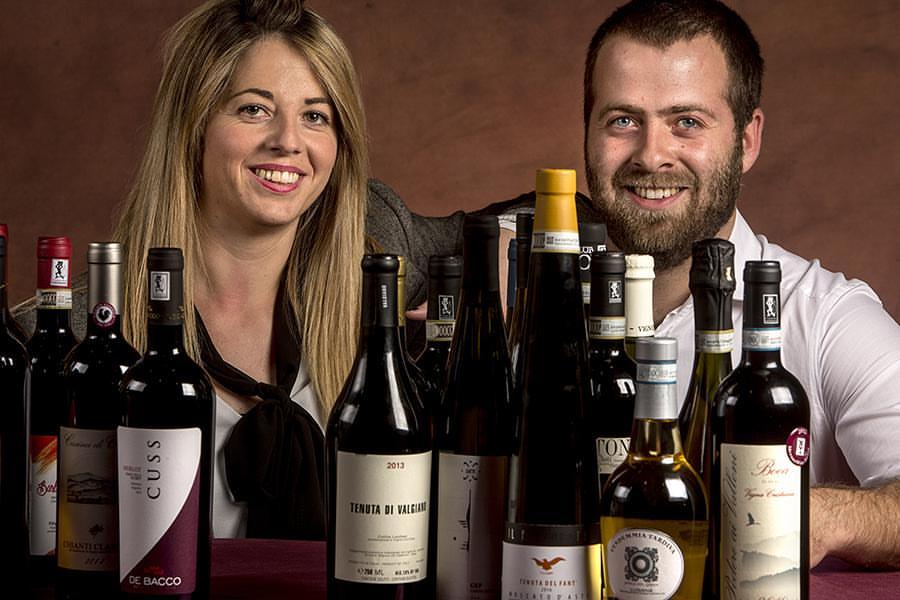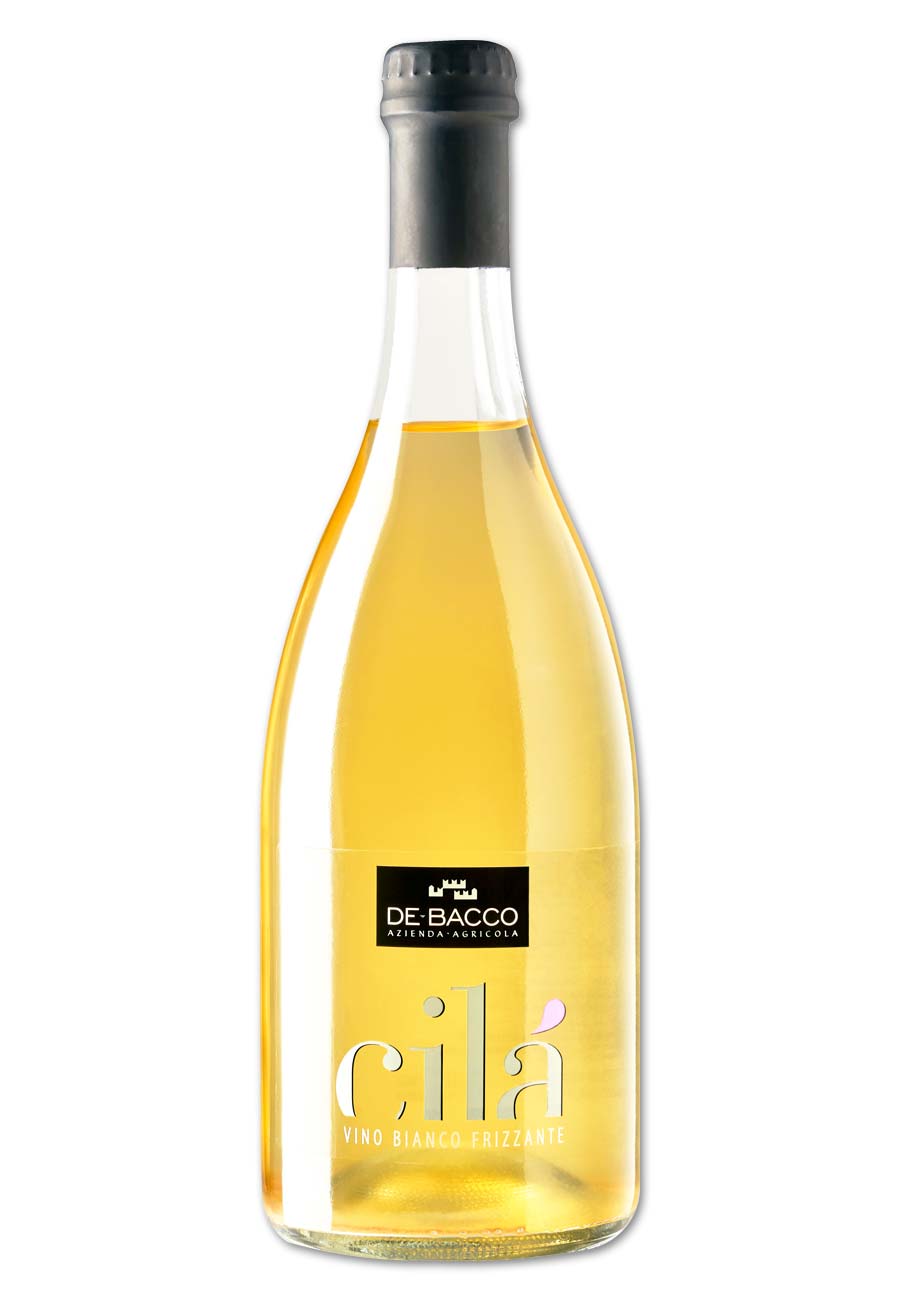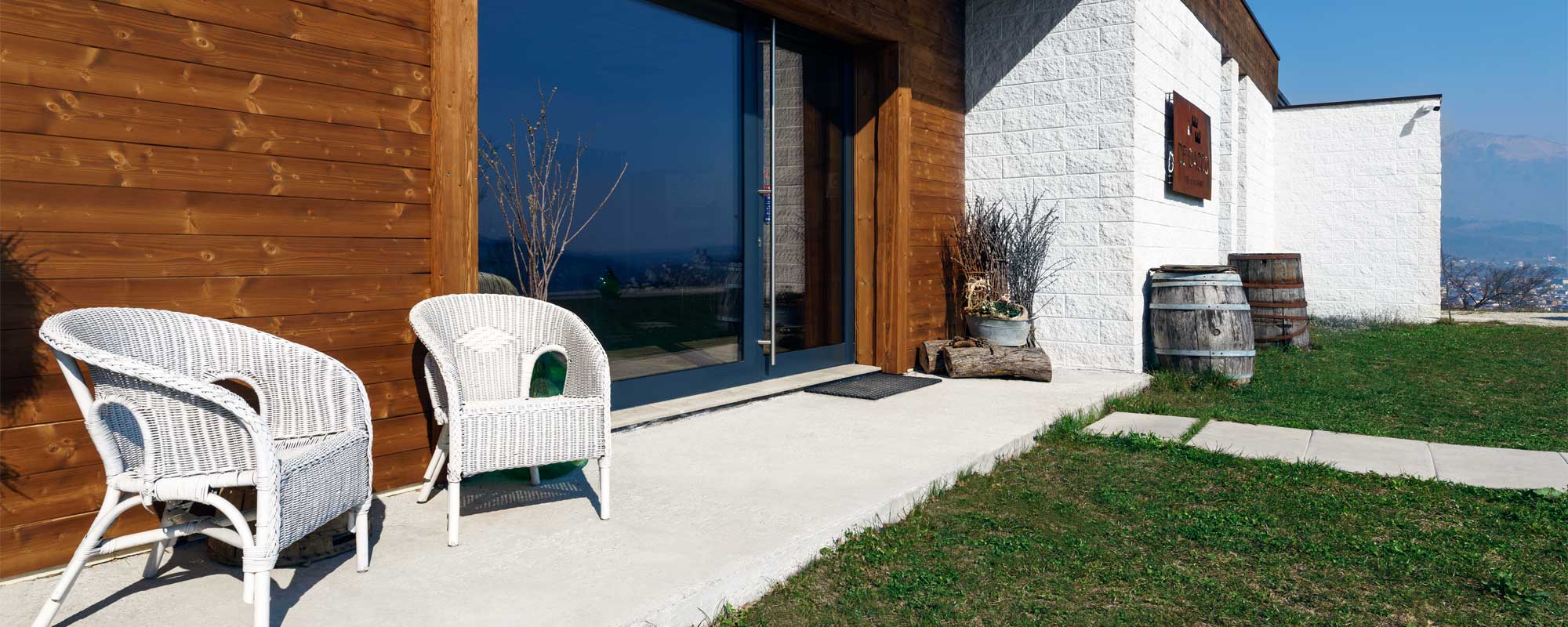We are Marco and Valentina, winegrower siblings who live under the Dolomites in the province of Belluno.
We didn’t think we would become winegrowers but the call of our hard, steep and sour land was strong. So strong that we transformed what was slightly more than a family passion to an actual job.
We are 28 and 30 years old, and in 2008 we became the owners of our grandfather’s agricultural holding: it had only a 2000 square metres of vineyard and the wine wasn’t made for sale.
Since 2008, we have invested in new systems; today we grow almost 9 hectares of vineyard.

In 2011 we inaugurated our winery. We started by restoring some local varieties such as the Gata, the Pavana and the Bianchetta; then we started growing some international wine grape variety such as Merlot, Pinot Noir, Teroldego, Traminer, Manzoni Bianco 6.0.13, and Chardonnay.
The place where everything started, the vineyard of our grandfather Pietro, didn’t have all these varieties, but only the local ones. There were also some Merlot grapevines that had been there for a long time and that maybe were waiting for us.
We believe in the biodiversity that makes Italy great: the Bianchetta and the Pavana are OUR varieties and we don’t want to forget this. They also offer a great opportunity to produce a unique and strongly marked wine.
Today we produce about 50.000 bottles of wine. It’s a restricted number, the grapes are for the most part worked manually, and the vineyards are mostly in sloping land on gravelly and calcareous conoids that can only be reached by foot. The phytosanitary treatments are minimized and we don’t use herbicide.
The yields per hectare are very low: with some tests on still white wine we can reach 30 quintal per hectare.
We are based in Feltre, under the Dolomites.
We decided to keep the plots small in order not to alter the landscape; they all are in the province of Belluno and the majority of them is in the mountain district of Feltre, which is the more suitable area for viticulture in the province, where grapevine was cultivated even in the past.
Viticulture in the district of Feltre was an actual source of income for the population until the early 1900s.
Unfortunately, over the years wine growing was abandoned because of wars, emigration and industrialization.
We love challenges, we love the idea that we didn’t come up with something new.
With perseverance and dedication we are getting back what was lost: we don’t want to abandon our beautiful land in the Dolomites.
Our products are the expression of a unique territory: its extreme growing characteristics produce some special and distinctive wines.
Our wine represents us.
It leaves the traditional schemes, it is not comparable to other wines, and it doesn’t have the slightest intention to follow the trend of the moment or to soften.
It is a wine that follows its way and wants to find the past glory that distinguished it.
Vanduja is for that person who has had enough of stereotypes: from the first sip you can taste the shades of a firm land.
JENIA
NAME:
WHITE IGT OF THE DOLOMITES VINEYARDS
PRODUCTION AREA:
Feltrina Valley
TYPE OF SOIL:
Strongly calcareous pebbly cones
VINES:
MANZONI 6.0.13, CHARDONNAY, GEWURZTRAMINER.
BREEDING SYSTEM:
Guyot
YIELD FOR HA:
30 50 ql.
HARVESTING:
Manual in box.
WINEMAKING:
the grapes are selected manually in the vineyard and carried, in a box of maximum 18 20kg, in the winery to avoid crushing the berries.
After having been destemmed and pressed, the must and the peelings are subjected to cold maceration or for 12 18 hours to extract the greatest number of aromatic precursors and polyphenols. After this there is a soft pressing and gradual heating up until fermentation temperature that lasts for about 15 20 days in
stainless steel tanks at controlled temperature. 2 or 3 batonnage a week are made regularly for four months. At the beginning of spring the wine is bottled and rests for 30 days before putting on the market.
ORGANOLEPTIC SHEET:
White wine with intense flaxen colors and golden reflections, structured. Aromatic and strong olfactory sensations with spicy notes like saffron, roses and lychee.
13.5% Vol. 75 cl.


CUSS
NAME:
MERLOT IGT OF THE DOLOMITES VINEYARDS
PRODUCTION AREA:
Feltrina Valley
TYPE OF SOIL:
Strongly calcareous pebbly cones
VINES:
MERLOT.
BREEDING SYSTEM:
Guyot and spurred cordon
YIELD FOR HA:
30 50 ql.
HARVESTING:
Manual in box.
WINEMAKING:
the grapes are selected manually in the vineyard and carried, in a box of maximum 18 20kg, in the winery to avoid crushing the berries.
After having been destemmed and pressed,the must and the peelings are subjected to red winemaking in stainless steel tanks with 25 days maceration, controlled temperature fermentation and regular replacement and fulling.
After the alcoholic fermentation there is a soft pressing and the malolactic fermentation.
The wine matures in stainless steel tank for another 2 months and then it ages in barrique for 2 months before bottling.
ORGANOLEPTIC SHEET:
Wine from Merlot grapes accurately selected, dark garnet red color and with delicately herbaceous and spicy sensations like raspberry and small undergroth fruits.The wine matches with game and feather game dishes, aged cheeses and red meat.
13% Vol. 75 cl.
VANDUJA
NAME:
PAVANA IGT OF THE DOLOMITES VINEYARDS
PRODUCTION AREA:
Feltrina Valley
TYPE OF SOIL:
Strongly calcareous pebbly cones
VINES:
PAVANA.
BREEDING SYSTEM:
Guyot and spurred cordon
YIELD FOR HA:
30 50 ql.
HARVESTING:
Manual in box.
WINEMAKING:
the grapes are selected manually in the vineyard and carried, in a box of maximum 18 20kg, in the winery to avoid crushing the berries.
After having been destemmed and pressed,the must and the peelings are subjected to red winemaking in stainless steel tanks with 25 days maceration, controlled temperature fermentation and regular replacement and fulling.
After the alcoholic fermentation there is a soft pressing and the malolactic fermentation.
The wine matures in stainless steel tank for another 2 months and then it ages in barrique for 2 months before bottling.
ORGANOLEPTIC SHEET:
Vanduja contains ancient and forgotten fragrances and sensations. In a glass we offer you an exciting journey between our mountains past glories and peasant traditions. This red wine shows herbaceous, undergroth small red fruits and vanilla notes. The taste confirms the olfactory sensations with a pleasant and definite memory.
13% Vol. 75 cl.


SACA
NAME:
SPUMANTE EXTRA DRY
PRODUCTION AREA:
Feltrina Valley
TYPE OF SOIL:
Strongly calcareous pebbly cones
VINES:
BIANCHETTA TREVIGIANA.
BREEDING SYSTEM:
Guyot and upturned guyot
YIELD FOR HA:
80 ql.
HARVESTING:
Manual in box.
WINEMAKING:
the grapes are selected manually in the vineyard and carried, in a box of maximum 18 20kg, in the winery to avoid crushing the berries.
After having been destemmed and pressed,the must and the peelings are subjected to white winemaking in stainless steel tanks with controlled temperature fermentation. At the end of fermentation the wine is racked and matured for a long period on fine lees and with regualar batonnage. The sparkling wine is done in autoclave tank for 80 days.
ORGANOLEPTIC SHEET:
Fine and persistent foam with flaxen colors and greenish reflections. It appears like Bellunese Bianchetta Trevigiana bubble.Tropical and fruity sensations with Mediterranean spices and flowers notes. It matches with elegant aperitifs.
11,5% Vol. 75 cl.
PAVANA
NAME:
SPUMANTE BRUT ROSE’
PRODUCTION AREA:
Feltrina Valley
TYPE OF SOIL:
Strongly calcareous pebbly cones
VINES:
PAVANA.
BREEDING SYSTEM:
Guyot and upturned guyot
YIELD FOR HA:
80 ql.
HARVESTING:
Manual in box.
WINEMAKING:
the grapes are selected manually in the vineyard and carried, in a box of maximum 18 20kg, in the winery to avoid crushing the berries.
The grapes are carefully placed inside the press. Here they are pressed with such duration and pressures as to give the must aromatic finesse.
After having been destemmed and pressed, the must and the peelings are subjected to white winemaking in stainless steel tanks with controlled temperature fermentation. At the end of the fermentation the wine is racked and matured for a long period on fine lees and with regular batonnage. The sparkling wine is done in autoclave tank for 80 days.
ORGANOLEPTIC SHEET:
Fine and persistent foam pink colors and fuchsia reflections.
With a pleasantly delicate scent of red fruits, excellent as an aperitif, with appetizers or fish dishes.
11,5% Vol. 75 cl.


CILÀ
“May the wine glass you are served benefits you. For your happiness, afar or close, alone or in company, here and there, simply Cilà”
DENOMINATION:
sparkling white wine with secondary fermentation in the bottle.
PRODUCTION AREA:
Feltrina Valley
TYPE OF SOIL:
strongly calcareous pebbly cones
VINES:
Bianchetta Trevigiana
BREEDING SYSTEM:
twice overturned
YIELD PER HA:
80 ql
HARVESTING:
manually in box
WINEMAKING:
the grapes are manually selected in the vineyard and taken in cases for a maximum of 18-20 kg in the wine cellar in order to not press the grape. After being destemmed and pressed, must and rind continue the traditional white vinification in stainless steel tanks in controlled temperature. At the end of the fermentation, it is poured and it starts a long period of maturation on thin lees and with continuous batonnage. It is put in the bottle late spring where it starts the secondary fermentation in the bottle and the ripening period on yeasts.
ORGANOLEPTIC SHEET:
Thin and persistent foam with a straw-yellow colour.
Fresh and intense to the nose with light hints of ripe fruit and bread crust.
11% Vol. 75 cl.
ICO
“The honest wine is the son of a persistent work in the wineyard”
DENOMINATION:
sparkling wine traditional method Brut Rosè
PRODUCTION AREA:
Feltrina Valley
TYPE OF SOIL:
strongly CALCAREOUS pebbly cones
VINES:
Pinot Noir
BREEDING SYSTEM:
guyot
YIELD PER HA:
80 ql
HARVESTING:
manually in box
WINEMAKING:
the grapes are manually selected in the vineyard and taken in cases for a maximum of 18-20 kg in the wine cellar in order to not press the grape. Then, very carefully, they are put inside the wine press. Here they are pressed for such a long time and such pressure that the must presents fine scents and not too intense nuances. Later, they continue the white vinification in stainless steel tanks in controlled temperature. At the end of the fermentation, they are poured and start a long period of maturation on thin lees and with continuous batonnage. After the draught, it starts the secondary fermentation in the bottles and the refinement sage on yeasts for at least 20 months. Finally, the impurities settled at the top of the bottle are removed at “volée” and the “liqueur d’expedition” is added. After 60 days, the wine is ready to be sold.
ORGANOLEPTIC SHEET:
shiny dusty rose, persistent foam, fine and continue perlage. Intense and enveloping at the nose, with fresh hints of small red fruits that prevail.
Elegant to the palate, with the typical freshness of the territory in which it is born, surprisingly harmonious and soft.
12% Vol. 75 cl.


RORO
“From the sweetest sound what instrument could I find than Roro with its leaves in the wind”
DENOMINATION:
Teroldego IGT Dolomites
PRODUCTION AREA:
Fonzaso and Colderù
TYPE OF SOIL:
strongly CALCAREOUS pebbly cones
VINES:
Teroldego
BREEDING SYSTEM:
guyot
YIELD PER HA:
30-40 ql
HARVESTING:
manually in box
WINEMAKING:
the grapes are picked up only as the phenolic maturity is reached, containing a large amount of sugars and anthocyans. It is the latest grape harvest for the Winery De Bacco, as it takes place after the first autumn frost and as the leaves start to fall. The grapes are manually selected in the vineyard and taken in cases for a maximum of 18-20 kg in the wine cellar in order to not press the grape. After being destemmed and pressed, must and rind continue the traditional white vinification in stainless steel tanks with extended maceration for 25 days and fermentation in controlled temperature repeatedly pumped over and punched down. At the end of the fermentation, it is softly poured and put in oak French barriques with medium-high toasting to continue the malolactic fermentation. It ripens in the barrique for 12 months and then hones in the bottles for another 10-12 months before being sold.
ORGANOLEPTIC SHEET:
red wine with marked violet glares with particular sensations of violet and cyclamen, with hints of wood, cinnamon and nutmeg. Harmonious and complex, its taste presents a hint of almond.
14% Vol. 75 cl.



